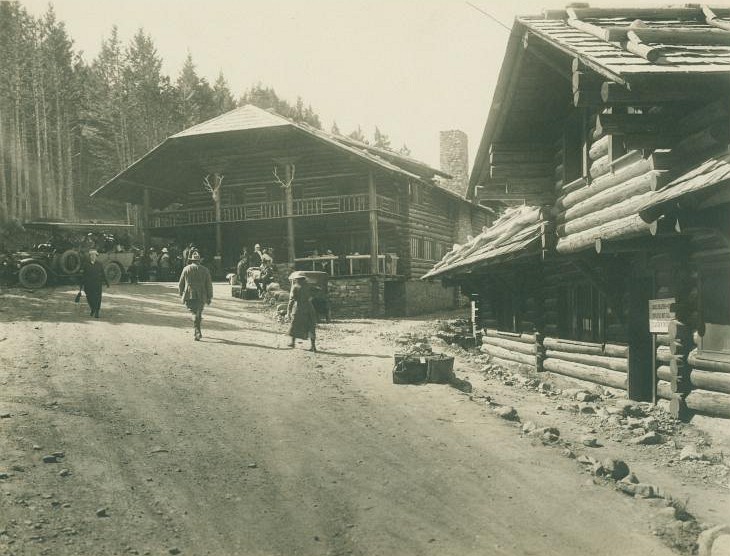The Underused Chalet
Located near the entrance to Glacier on St. Mary Lake, today's national park lodging enthusiast would find it nearly incomprehensible that St. Mary Chalets was virtually ignored by prospective overnight guests during its brief history. Were it operational today, it seems likely that such a complex would sell out a year in advance. But because it was built when it was, located where it was, St Marys Chalets fell victim to a number of circumstances that hastened its demise in less than three decades.
Because it was hastily built, St Mary Chalets opened earlier than most of the other lodges and was an immediate success. But because Going-to-the-Sun Chalets was so close by, word soon spread that as good as St Mary's was, the location of Going-to-the-Sun was exponentially more stunning. While Going-to-the-Sun Chalets commanded a million dollar view from a high rock precipice, St Mary Chalets was located at what was the very beginning of the mountains. It was really a nether land where the plain ended and the mountains began, so it felt to travelers as if they weren't quite "there" yet. Still, guests traveling from the rail terminus via stagecoach arrived too late in the day to continue on, so St Mary Chalets was well used during its early years.
According to Glacier's Historic Hotels & Chalets: View with a Room by Ray Djuff, Louis F. Hill and Chris Morrison, the stage service was unreliable and discontinued in favor of the now-famous red buses. Because this brought travelers into St Mary's during the morning hours, they had plenty of time to relax and regroup prior to the scheduled boat trip to Going-to-the-Sun. So while they filled the dining hall, the complex was emptied out before nightfall.
This void was partly filled by the changing landscape of American roads and the rise of the family automobile during the 1920s. While many travel enthusiasts were accustomed to setting up camp along roadways, the auto enabled them to push further and later, leaving many too weary to tend camp. A rise in personal wealth also put rented beds within their grasp. And so in the early 1920s the St Mary Chalets was the only real lodging option, and it was located right along the unpaved Blackfeet Highway.
Unfortunately the road was reconstructed in 1926, and was realigned outside the park through what is today the village of St. Mary. This left the Chalets at the end of a long side road. Services soon sprouted outside the park at St. Mary, and by 1932 these included a modern motor court cabin complex. Even the opening of Going-to-the-Sun Highway in 1933 didn't help. Although it followed the side road into the park, it too bypassed the Chalets.
The motor courts and cabins in St. Mary proved to be the straw that broke the Chalets. Offering modern plumbing in tiny but private baths within the guest quarters were far more appealling to motorists than communal bath buildings. Today this pendulum has swung the other way; National Park visitors are more than willing to use central showers in exchange for a pseudo-wilderness experience.
But the most injurious weapon of the private motor hotels wasn't plumbing...it was price. Owned and staffed by families, these tourist cabins didn't adhere to the strict service codes of the Great Northern Railway, and the services were generally provided by family members. Thus the private lodgings could provide brand new accommodations at a fraction of the Chalets' cost. Considering that newness, and that the Chalet complex was worn out after being battered by 20 brutal winters and hordes of dusty travelers, the decrease in overnight guests was dramatic. Enter the Great Depression, and the pricey St Mary Chalets were virtually empty.
Thus overnight lodging was discontinued in 1934, although the railroad continued to operate the boat launch, restaurant, and camp store.
An interesting twist for St Mary Chalets -- unique in the history of NPS lodges -- coincided with the closing of the overnight services. Artist Winold Reiss approached Great Northern about possibly opening an art school somewhere near Glacier. Reiss had been a favorite among railway executives, who commissioned much of his native American work. It seemed an ideal use for the Chalets: Employees could be kept on, and the buildings would be used and could be maintained. Profitability was of lesser consequence. It was assumed that having working artists and activity at the site would increase traffic at the dining room and curio shoppe, as well as the launch service.
So the Great Northern Railway became de facto partners with the New York School of Fine Arts, and a community of art teachers and students from "back east" flocked to St Mary Chalets. Unfortunately the school was unsuccessful even by the Depression's diminished standards, and art school operations ceased in 1937. The guest rooms fell silent.
When the railway opened the East Glacier Auto Cabins in 1940, lodging at Going-to-the-Sun Chalets was severely impacted, and operations at the St Mary launch slowed considerably in August 1941. The question of what to do with the St Mary Chalets was answered by the guns of World War II. Legend has it that the complex was considered as a center for arctic battle training, but this never came to fruition. The chalets were dimantled and removed in 1943, interestingly enough, by Hugh Black, one of the St Mary auto cabin concessionaires who hastened its downfall. Black's modest cabins evolved into the massive St. Mary Lodge and Resort. Although it is highly probable that Black used some materials from the Chalets in his ever-growing complex, there are no known records to support this. After so many years and numerous rounds of renovations and new construction, any attempts to locate these materials would be fruitless.


